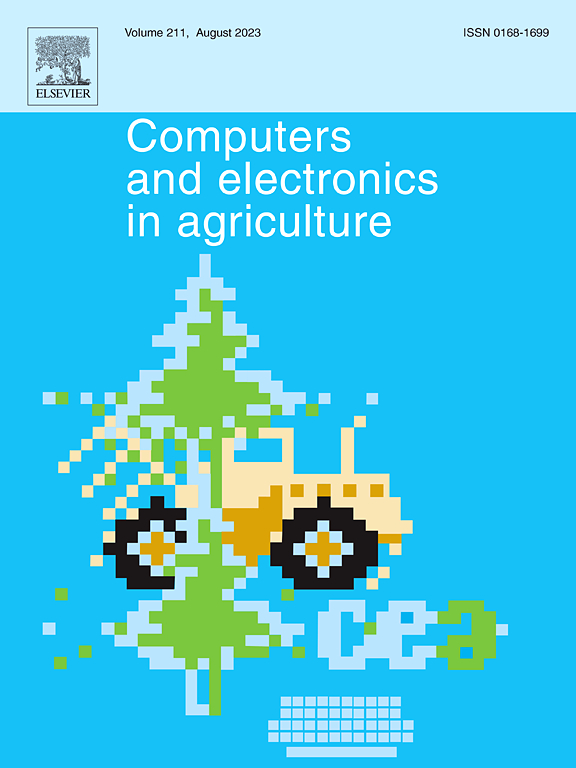Fault detection in the sniffer-based gas emission measurement systems
IF 8.9
1区 农林科学
Q1 AGRICULTURE, MULTIDISCIPLINARY
引用次数: 0
Abstract
To ensure the demanded sustainability level in relation to methane emissions during the animal-based production, the continuous emissions monitoring and the diverse emissions mitigation strategies are actively demanded. In this context, a proper measurement technique plays a crucial role. The “sniffers” is relatively novel measurement technique which became favored during the last several years for large-scale methane measurements in commercial farms and to these days is among the most used techniques in cattle. This study addressed the problem of fault detection in such measurement systems. The problem was formulated for the first time and was considered as the model-free detection for stochastic signals with limited prior information. The novel detection approach was developed, verified and analyzed. Specifically, the data model for sniffers measurements was formulated in terms of indexed stochastic processes. To account the effect of non-trivial complex noise in the data, the approach to data transformation based on the Karhunen-Loeve expansion was proposed. Upon this, the fault detection was formulated as the statistical hypothesis-testing problem and the sufficient test statistic was derived alongside with the related threshold. Among the novel results, a formalized notion of an unreliable data is provided in the context of fault detection. The general detection procedure requires calculation of signals’ covariance matrices (constructed from the related trajectory matrices), their diagonalization to allow signals approximation by the Karhunen-Loeve expansion; and calculation of the derived test statistic using the approximated signals. The proposed approach was verified using simulated and real data. Validation tests showed that the use of Karhunen-Loeve transformed signals demonstrate better detection rate than the non-transformed signals. Overall, the proposed approach found to be robust and suitable to automated off-line and on-line data processing.
基于嗅探器的气体排放测量系统的故障检测
为了确保在以动物为基础的生产过程中甲烷排放达到所需的可持续性水平,积极需要持续的排放监测和各种减排战略。在这种情况下,适当的测量技术起着至关重要的作用。“嗅探器”是一种相对新颖的测量技术,在过去几年里,它在商业农场的大规模甲烷测量中得到了青睐,直到今天,它还是牛身上使用最多的技术之一。本研究解决了此类测量系统中的故障检测问题。该问题首次被公式化,被认为是对有限先验信息的随机信号的无模型检测问题。开发了新的检测方法,并对其进行了验证和分析。具体来说,嗅探器测量的数据模型是根据索引随机过程来制定的。为了考虑数据中复杂噪声的影响,提出了一种基于Karhunen-Loeve展开的数据变换方法。在此基础上,将故障检测表述为统计假设检验问题,并推导出充分的检验统计量和相应的阈值。在这些新颖的结果中,在故障检测的背景下提供了不可靠数据的形式化概念。一般的检测过程需要计算信号的协方差矩阵(由相关的轨迹矩阵构造),它们的对角化允许通过Karhunen-Loeve展开进行信号逼近;并利用近似信号计算导出的检验统计量。仿真和实际数据验证了该方法的有效性。验证试验表明,使用Karhunen-Loeve变换信号比未变换信号具有更好的检测率。总体而言,所提出的方法鲁棒性好,适用于离线和在线自动数据处理。
本文章由计算机程序翻译,如有差异,请以英文原文为准。
求助全文
约1分钟内获得全文
求助全文
来源期刊

Computers and Electronics in Agriculture
工程技术-计算机:跨学科应用
CiteScore
15.30
自引率
14.50%
发文量
800
审稿时长
62 days
期刊介绍:
Computers and Electronics in Agriculture provides international coverage of advancements in computer hardware, software, electronic instrumentation, and control systems applied to agricultural challenges. Encompassing agronomy, horticulture, forestry, aquaculture, and animal farming, the journal publishes original papers, reviews, and applications notes. It explores the use of computers and electronics in plant or animal agricultural production, covering topics like agricultural soils, water, pests, controlled environments, and waste. The scope extends to on-farm post-harvest operations and relevant technologies, including artificial intelligence, sensors, machine vision, robotics, networking, and simulation modeling. Its companion journal, Smart Agricultural Technology, continues the focus on smart applications in production agriculture.
 求助内容:
求助内容: 应助结果提醒方式:
应助结果提醒方式:


